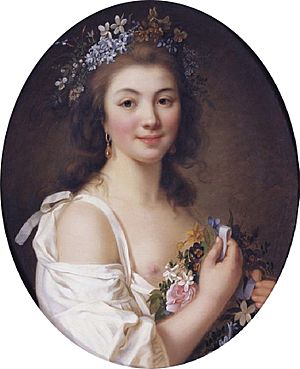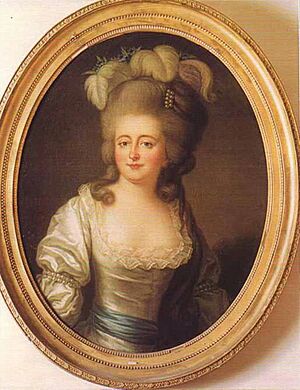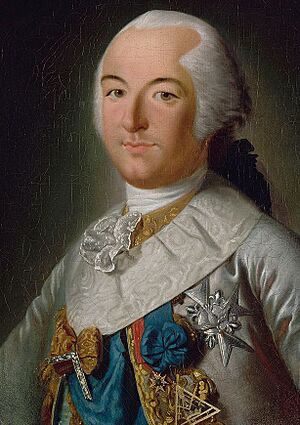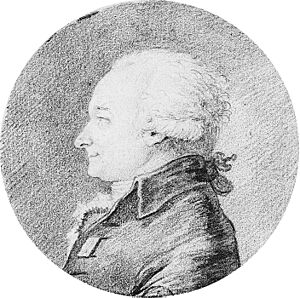Stéphanie Félicité, comtesse de Genlis facts for kids
Quick facts for kids
Stéphanie Félicité du Crest, Madame de Genlis
|
|
|---|---|
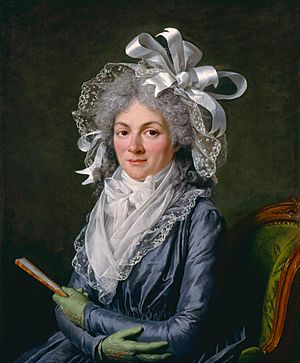
Madame de Genlis (1746–1830)
|
|
| Born | Caroline-Stéphanie-Félicité du Crest de Saint-Aubin 25 January 1746 Issy-l'Évêque, Saône-et-Loire |
| Died | 31 December 1830 (aged 84) Paris |
| Resting place | Père Lachaise Cemetery |
| Occupation | Author, educationalist |
| Language | French |
| Citizenship | France |
| Genre | Novels |
| Subject | Historical romance Sentimental novel |
| Notable works | Mémoires inédits sur le XVIII' siècle; Adèle et Théodore |
| Spouse | Charles-Alexis Brûlart, Comte de Genlis (1763; separated 1782) |
| Children | Caroline (1765-86), Pulchérie (1767-1847) and Casimir (1768-1773) |
| Relatives | Madame de Montesson |
Caroline-Stéphanie-Félicité, Madame de Genlis (born January 25, 1746 – died December 31, 1830) was a famous French writer. She lived during the late 1700s and early 1800s. Madame de Genlis was well-known for her novels and her new ideas about how to educate children. Today, people remember her best for her journals. These journals give us a great look into her life and the times she lived in.
Contents
Life Story of Madame de Genlis
Caroline-Stéphanie-Félicité du Crest de Saint-Aubin was born on April 25, 1746. Her birthplace was Champcéry, near Autun, in France. Her parents were Pierre César du Crest and Marie Françoise Félicité Mauget de Mézières.
Early Challenges and Talents
Her family faced financial problems because of her father's debts. In 1757, they had to sell their home and move to Paris. During this time, Stéphanie-Félicité and her mother stayed at the homes of wealthy friends. There, she learned many skills. She studied dancing from a ballet master and singing from Ferdinando Pellegrini. She also became very good at playing the harp. In Paris, she and her mother relied on her harp-playing skills to make a living.
Marriage and Family Life
In 1760, her father was captured by the English. While imprisoned, he met Charles-Alexis Brûlart, Comte de Genlis. After they were both released, her father introduced Charles-Alexis to his daughter. Pierre died in 1763. Stéphanie-Félicité and Charles-Alexis married on November 8, 1763. She became known as Madame de Genlis.
They lived with Charles-Alexis's godfather, the Marquis de Puisieux. They had three children: Caroline (born 1765), Pulchérie (born 1767), and Casimir (born 1768).
Her First Famous Novel
In 1782, Madame de Genlis published her first novel, Adèle et Théodore. She wrote it while on holiday in Italy. The main idea of the book was about education. She believed that a woman's place in society depended on her education. This was different from other thinkers of her time, like Jean-Jacques Rousseau. He thought women's education should be mostly for home life. Madame de Genlis believed education could help women gain more freedom. This novel was very successful. She became the first woman to be a "governor" (teacher) for royal princes.
Madame de Genlis passed away in Paris on December 31, 1830. She was buried in Père Lachaise Cemetery.
Madame de Genlis's Career and Influence
Madame de Genlis had a relative named Madame de Montesson. She was known for her beauty and intelligence. Madame de Montesson married the duc d'Orléans in 1773. With her aunt's help, Stéphanie-Félicité became a lady-in-waiting to Louise Marie Adélaïde de Bourbon. She was the wife of the Duke's son, Philippe d'Orléans, Duke of Chartres. In 1772, Madame de Genlis and her husband joined the Duke's household.
Becoming a Royal Educator
In 1777, the Duke of Chartres appointed Madame de Genlis as the governess for his daughters. She also took in two English girls, Stephanie Caroline Anne Syms (known as "Pamela") and Hermine Syms. This was part of her teaching plan. She wanted her students to learn foreign languages by being around children from different countries. Her home already had English and Italian servants.
In 1781, the Duke of Chartres made an unusual decision. He put Madame de Genlis in charge of his sons' education. This led to their previous teachers leaving. She and her husband, Charles-Alexis, officially separated the next year.
Developing Educational Methods
Madame de Montesson had her own theatre. Madame de Genlis helped write plays for it. Their children acted in these plays. This helped Madame de Genlis develop her teaching ideas. She later wrote about them in books like Théâtre d'éducation (1779–1780). This was a collection of short comedies for young people. She also wrote Les Annales de la vertu (1781) and Adèle et Théodore (1782).
People said she used many modern teaching methods. For example, she taught history using magic lantern slides. Her students learned botany from a botanist during their walks.
Life During the French Revolution
In 1785, the Duke of Chartres became the duc d'Orléans. When the French Revolution started in 1789, both he and Charles-Alexis joined a political group called the Girondins. Sadly, they were both executed in 1793. Madame de Genlis and her student, Mademoiselle d'Orléans, found safety in Switzerland. They later moved to Berlin in 1794.
Return to France and Later Years
After Napoleon came to power in 1799, Madame de Genlis returned to France. Her aunt was a close friend of Napoleon's wife, Joséphine de Beauharnais. Because of this connection, Madame de Genlis was given rooms and a small pension (regular payment). Her well-known romance novel, Mademoiselle de Clermont, was published in 1802.
Her government pension stopped after the Bourbon Restoration in 1814. Her former student, Louis Philippe, gave her a small pension. But she mostly relied on money from her writing.
In her later years, she had some literary disagreements. For example, in 1822, she published Diners du Baron d'Holbach. In this book, she criticized what she saw as the "intolerance" of the thinkers of the 18th century. She lived long enough to see her former student, Louis Philippe, become king in 1830. Most of her works are not widely read today. However, her memoirs, Mémoires inédits sur le XVIII' siècle (published in 1825), offer interesting historical details.
Her Impact on Literature and Education
In Britain, Madame de Genlis was famous for her children's books. Many people liked them because they used some of Rousseau's teaching ideas. Her books also avoided certain topics that were often linked with French writers at the time. People in Britain liked her new educational methods, especially her plays that taught good morals.
Influence on Jane Austen
The famous British author Jane Austen knew Madame de Genlis's works. Austen mentioned her in her novel Emma. In the book, the main character suggests that a governess would be better at raising her own daughter after practicing on someone else's. She compares this to a character in Madame de Genlis's Adèle et Théodore. Modern experts say that other ideas from Genlis's works appear in Austen's Emma and Northanger Abbey. Austen continued to read and share Genlis's books.
Inspiring Other Writers
British women writers of the late 1700s were especially inspired by Genlis's educational novel, Adèle et Théodore. Anna Letitia Barbauld compared it to Rousseau's Emile. She admired Genlis's "system of education," where teaching was shown through actions. Clara Reeve also praised Genlis's educational program. Other books, like Anna Letitia Barbauld and John Aikin's Evenings at Home, were inspired by Genlis's Tales of the Castle. This book was a spin-off from Adèle et Théodore. Genlis's focus on mothers as strong educators was very inspiring. Her books also showed how to create simple teaching tools, like flash cards.
Madame de Genlis in Other Books
Félicité de Genlis appears as a character in books by famous authors. These include Honoré de Balzac (in Illusions perdues) and Victor Hugo (in Les Misérables). She is also mentioned in:
- War and Peace by Leo Tolstoy
- Our Village by Mary Russell Mitford
- Oblomov by Ivan Goncharov
- The Angel in the House by Coventry Patmore
- The Rector of Justin by Louis Auchincloss
- Nausea by Jean-Paul Sartre
- Emma by Jane Austen
Selected Works by Madame de Genlis
Madame de Genlis wrote a huge number of books. As the writer Saint-Beuve once said, "if the inkstand had not existed, she would have invented it." Here are a few of her important works:
- Théâtre à l'usage des jeunes personnes, ou Théâtre de l'éducation (1779–1780): A collection of plays for young people.
- Adèle et Théodore, ou, Lettres sur l'éducation (1782): Her famous novel about education.
- Les Veillées du château, ou Cours de morale à l'usage des enfants (1784): Moral stories for children, also known as Tales of the Castle.
- Mademoiselle de Clermont (1802): A historical romance novel.
- Mémoires inédits sur le XVIII' siècle (1825): Her memoirs, which provide a look into her life and times.
See also
 In Spanish: Madame de Genlis para niños
In Spanish: Madame de Genlis para niños


